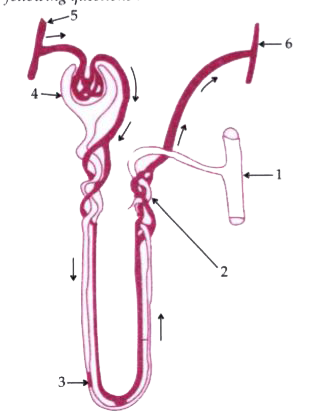In mammals, which blood vessel would normally carry largest amount of urea
Renal vein
Dorsal aorta
Hepatic vein
Hepatic portal vein
The correct Answer is:C
To determine which blood vessel in mammals carries the largest amount of urea, we can analyze the options provided:
1. Understanding Urea Production: Urea is primarily produced in the liver as a result of protein metabolism. Therefore, any blood vessel that is closely associated with the liver is likely to carry significant amounts of urea.
2. Analyzing the Options:
- Option A: Renal Vein: This vessel carries blood away from the kidneys. While the kidneys filter urea from the blood, they do not produce it.
- Option B: Dorsal Aorta: This is a major artery that carries oxygenated blood from the heart to the body. It does not specifically carry urea.
- Option C: Hepatic Vein: This vessel carries blood away from the liver. Since urea is produced in the liver, the hepatic vein would carry the largest amount of urea.
- Option D: Hepatic Portal Vein: This vein carries blood from the gastrointestinal tract and spleen to the liver. While it does carry substances absorbed from the intestines, it does not carry the largest amount of urea.
3. Conclusion: Given that the hepatic vein carries blood away from the liver, where urea is produced, it follows that the hepatic vein would carry the largest amount of urea.
Thus, the correct answer is Option C: Hepatic Vein.
- Option A: Renal Vein: This vessel carries blood away from the kidneys. While the kidneys filter urea from the blood, they do not produce it.
- Option B: Dorsal Aorta: This is a major artery that carries oxygenated blood from the heart to the body. It does not specifically carry urea.
- Option C: Hepatic Vein: This vessel carries blood away from the liver. Since urea is produced in the liver, the hepatic vein would carry the largest amount of urea.
- Option D: Hepatic Portal Vein: This vein carries blood from the gastrointestinal tract and spleen to the liver. While it does carry substances absorbed from the intestines, it does not carry the largest amount of urea.
Topper's Solved these Questions
- BOOK - AAKASH SERIESCHAPTER - BODY FLUIDS AND CIRCULATIONEXERCISE - Exercise -II (Disorders of Circulatory System)8videos
BODY FLUIDS AND CIRCULATION
- BOOK - AAKASH SERIESCHAPTER - BIOTECHNOLOGY AND ITS APPLICATIONSEXERCISE - Exercise - III (Previous AIPMT/NEET Questions )19videos
BIOTECHNOLOGY AND ITS APPLICATIONS
- BOOK - AAKASH SERIESCHAPTER - BREATHING AND EXCHANGE OF GASES EXERCISE - EXERCISE-III (Previous AIPMT/NEET Questions)21videos
BREATHING AND EXCHANGE OF GASES
Similar Questions
Knowledge Check
- Question 1 - Select One
Which blood vessel carries least amount of urea?
Apulmonary veinBrenal arteryCrenal veinDhepatic protal vein
Which blood vessel has the largest amount of urea ?
View SolutionWhich blood vessel contains the least amount of urea ?
View SolutionWhich one of the following blood vessel in mammals contains least amount of urea :
View SolutionWhich one of the following blood vessel in mammals contains least amount of urea :
View SolutionThe given diagram represents a nephron and its blood supply. Study the diagram and answer the question :

Name the blood vessel which contains the least amount of urea in this diagram.View SolutionBlood of which vessel in mammals carries least percentage of urea ?
View SolutionThe diagram below represents the simplified pathway of the circulation of blood. Study the same and answer the questions that follow :

Which blood vessel will contain a high amount of glucose and amino acids after a meal ?View Solution

